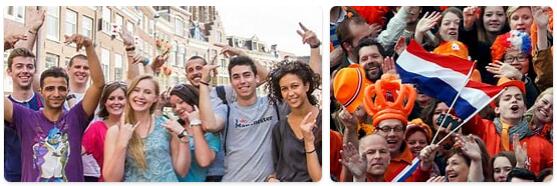The Netherlands is traditionally a Christian country, where both Protestantism and Catholicism have been represented for hundreds of years. Today, the country is also characterized by a large Muslim population, and that a large proportion of the population does not belong to any religious community.
There are several Reformed denominations, with a total of 23 percent of the population, mostly in the north. The largest is the former national church (Nederlandse Hervormde Kerk), which has support from 15 percent of the population. The Catholic Church comprises 32 percent. 4.3 percent are Muslims, while a large proportion of the population state that they do not belong to any religious community.
The Holocaust hit the Jewish minority in the Netherlands hard: There were about 140,000 Jews living in the country in 1940, while in 2018 there were only about 40,000 living there.

History
Medieval
Germanic tribes in what is today the Netherlands and Belgium were Christianized in the 400s (Franks) and in the 800s (Frisians and Saxons). In the late Middle Ages, the Netherlands was the center of monastic-like groups of laymen (beginners) and lay women (beginners) who emphasized the inner god experience and reading the Bible in the vernacular, and in the Renaissance there was a Catholic humanism (Erasmus Roterodamus).
Reformation
According to thesciencetutor, the Reformation in the Netherlands was not uniform: Both Lutherans and Gypsy peoples (for example, Mennonites) asserted themselves, but with time the reformed (Calvinist) direction became dominant.
Protestants were initially strongest in the southern provinces (present-day Belgium), but during the Eighty Years War they were hunted north, and when the northern provinces formed an independent republic in 1579, it was dominated by the Calvinists and the Reformed Church gained official status..
Republic
When the Eighty Years War ended in 1648, the Dutch republic gained boundaries reminiscent of today’s. The southern parts, however, had been under Spanish rule for decades, and therefore remained Catholic. In this way, a distinction was obtained in which the area corresponding to today’s provinces of Noord-Brabant and Limburg gained Catholic majority (like today’s Belgium), while the rest of the Netherlands was dominated by the Protestants. This religious divide between the north and the south continues until modern times.
Many areas, especially cities, in the Netherlands had a certain degree of tolerance in the 1700s and 1700s: people with religions other than Calvinistic Christianity were allowed to settle there. Particularly widespread was this tolerance in Amsterdam, where both Jews and Lutherans were allowed to build their own god houses. Catholicism was more strictly regulated: Their churches did not have to look like gods from outside. This was far more tolerant than many places in Europe, but religious minorities were nonetheless discriminated against in that only Calvinists could hold public office.
Recent times
In 1815, the Netherlands became a kingdom, but the state and church (the Reformed church) were separated in 1848. According to a census of the following year, 54.8 percent of the population was Reformed, 38.3 percent Catholic, 4.9 percent were other Protestants, and 1.9 percent were Jews.
The period from 1850 onwards is characterized by Catholic emancipation: In 1857 Catholics were given the right to become government officials, and confessional religious education was abolished in public schools. In the second half of the 19th century, Catholics founded more and more organizations, and several Catholic churches were built. In the political settlement of 1917, both Protestants and Catholics were given the right to organize their own schools, and the following year Charles Ruijs de Beerenbrouck became the country’s first Catholic prime minister.
